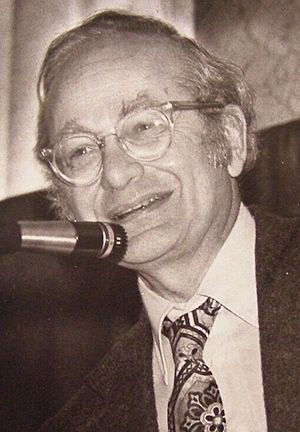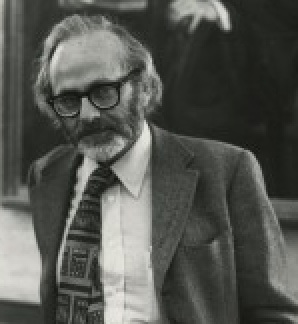David H. Hubel facts for kids
Quick facts for kids
David H. Hubel
|
|
|---|---|

Hubel in 1992
|
|
| Born |
David Hunter Hubel
February 27, 1926 Windsor, Ontario, Canada
|
| Died | September 22, 2013 (aged 87) Lincoln, Massachusetts, U.S.
|
| Nationality | American-Canadian |
| Alma mater | McGill University |
| Known for | Visual system |
| Spouse(s) |
Ruth Izzard
(m. 1953) |
| Awards |
|
| Scientific career | |
| Fields | Neurophysiologist |
| Institutions |
|
David Hunter Hubel (February 27, 1926 – September 22, 2013) was an American-Canadian neurophysiologist. This means he was a scientist who studied how the brain and nervous system work, especially focusing on how our bodies function. He was famous for his research on the visual cortex, which is the part of the brain that helps us see.
Hubel shared the 1981 Nobel Prize in Physiology or Medicine with Torsten Wiesel and Roger Sperry. They won the prize for their amazing discoveries about how our visual system processes information. For most of his career, Hubel worked as a professor at Johns Hopkins University and Harvard Medical School.
Contents
Early Life and Education
David H. Hubel was born in Windsor, Ontario, Canada, in 1926. His family moved to Montreal in 1929, where he grew up. His father was a chemical engineer, and David became very interested in science from a young age. He loved doing experiments in chemistry and electronics.
He went to Strathcona Academy for twelve years, where he learned a lot from his teachers. He later studied mathematics and physics at McGill University. After that, he went to medical school at McGill and became a doctor in 1951. He then spent three years training at the Montreal General Hospital.
His Scientific Career
In 1954, Hubel moved to the United States to work at Johns Hopkins School of Medicine. He later joined the army and served at the Walter Reed Army Institute of Research. There, he started studying the primary visual cortex of cats. This is the main part of the brain that receives visual information.
While in the army, he invented a new type of metal microelectrode and a special device called a hydraulic microdrive. These tools helped him record signals from tiny brain cells. In 1958, Hubel went back to Johns Hopkins and began working with Torsten Wiesel. Together, they made important discoveries about how the visual cortex is organized. A year later, he joined Harvard University.
Discoveries About Vision
Hubel and Wiesel's experiments greatly increased our understanding of how we see. Their partnership lasted over twenty years and became one of the most famous research teams in science.
In one experiment in 1959, they put a tiny electrode into the primary visual cortex of a sleeping cat. They then showed patterns of light and dark lines on a screen in front of the cat. They found that some brain cells, called neurons, would fire very quickly when they saw lines at a certain angle. Other neurons responded best to different angles or to light and dark patterns differently. Hubel and Wiesel called these "simple cells."
They also found other neurons, which they called "complex cells." These cells could detect edges no matter where they were on the screen and could even sense motion in certain directions. These studies showed how our visual system builds up a complex picture of what we see from simple features like lines and edges.
Hubel and Wiesel won the Nobel Prize for two main reasons:
- First, they described how the visual system develops, including how "ocular dominance columns" are formed. These are groups of brain cells that respond mostly to one eye.
- Second, they showed how signals from the eye are processed in the brain to create "detectors" for edges, motion, depth (how far away things are), and color. These detectors are like building blocks that help us understand the visual world.
They also did experiments where they prevented kittens from using one eye for a while. They found that the part of the brain that normally received signals from the unused eye was taken over by the other eye. This discovery was very important for understanding amblyopia, also known as "lazy eye." This condition can cause vision loss if one eye doesn't get enough visual input during a special time in childhood called the "critical period." Their work also showed why binocular vision (using both eyes together for depth perception) might not develop properly if one eye is affected.
Hubel and Wiesel's research helped doctors understand and treat childhood eye problems like cataracts and strabismus (crossed eyes). Their work also showed how flexible and adaptable the brain is, a concept called cortical plasticity.
Their understanding of how animals process visual information also inspired new technologies. For example, it helped create the SIFT descriptor, which is used in computer vision. This technology helps computers recognize objects and match images, similar to how our brains process visual information.
Personal Life
David Hubel married Ruth Izzard in 1953. They had three sons and four grandchildren. Ruth passed away in February 2013. David Hubel died in Lincoln, Massachusetts on September 22, 2013, at the age of 87, due to kidney failure.
See also
 In Spanish: David Hunter Hubel para niños
In Spanish: David Hunter Hubel para niños
- Neocognitron


